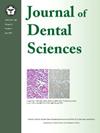口腔鳞状细胞癌预后因素和基因组变异的性别差异:一项5年回顾性研究
IF 3.4
3区 医学
Q1 DENTISTRY, ORAL SURGERY & MEDICINE
引用次数: 0
摘要
背景/目的本研究探讨了男性和女性口腔鳞状细胞癌(OSCC)患者的预后因素和基因组变异,重点关注女性OSCC发病率的上升。材料和方法利用2013年至2018年在国立台湾大学医院治疗的98例OSCC病例的数据,分析了患者队列、临床特征和基因组图谱。结果女性患者易患舌癌,男性患者易患颊癌。主要预后因素包括年龄超过55岁、舌癌、女性患者饮酒、男性患者咀嚼槟榔和吸烟。值得注意的是,有舌头OSCC或没有口腔习惯的女性5年生存率较低。基因组分析显示,有高危习惯的雄性小鼠抗原加工和活性氧基因组升高,而低风险的雌性小鼠代谢途径失调。免疫方面,女性患者naïve B细胞较少,抑制性M2巨噬细胞较高。结论我们的研究结果突出了与性别相关的OSCC预后差异,并提示针对特定危险因素和基因组特征的个性化治疗可能改善临床结果,特别是对于女性OSCC患者。本文章由计算机程序翻译,如有差异,请以英文原文为准。
Sex differences in prognostic factors and genomic variations in oral squamous cell carcinoma: A 5-year retrospective study
Background/purpose
This study examined the prognostic factors and genomic variations in oral squamous cell carcinoma (OSCC) among male and female patients, focusing on the rising incidence of OSCC in women.
Materials and methods
Using data from 98 OSCC cases treated at National Taiwan University Hospital between 2013 and 2018, the study analyzed the patient cohort, clinical characteristics, and genomic profiles.
Results
The Female patients had a higher incidence of tongue cancer, while the male patients were prone to have buccal cancer. Key prognostic factors included age over 55 years, tongue cancer, alcohol use in female patients as well as the buccal cancer, betel chewing, and smoking in male patients. Notably, women with tongue OSCC or without oral habits had poorer 5-year survival rates. Genomic analysis revealed the males with high-risk habits had elevated antigen-processing and reactive oxygen gene sets, whereas the low-risk females showed dysregulation in metabolic pathways. Immunologically, the female patients had fewer naïve B cells and higher suppressive M2 macrophages.
Conclusion
Our findings highlight distinct sex-related OSCC prognosis differences and suggest that personalized treatments targeting specific risk factors and genomic characteristics may improve the clinical outcomes, particularly for the female OSCC patients.
求助全文
通过发布文献求助,成功后即可免费获取论文全文。
去求助
来源期刊

Journal of Dental Sciences
医学-牙科与口腔外科
CiteScore
5.10
自引率
14.30%
发文量
348
审稿时长
6 days
期刊介绍:
he Journal of Dental Sciences (JDS), published quarterly, is the official and open access publication of the Association for Dental Sciences of the Republic of China (ADS-ROC). The precedent journal of the JDS is the Chinese Dental Journal (CDJ) which had already been covered by MEDLINE in 1988. As the CDJ continued to prove its importance in the region, the ADS-ROC decided to move to the international community by publishing an English journal. Hence, the birth of the JDS in 2006. The JDS is indexed in the SCI Expanded since 2008. It is also indexed in Scopus, and EMCare, ScienceDirect, SIIC Data Bases.
The topics covered by the JDS include all fields of basic and clinical dentistry. Some manuscripts focusing on the study of certain endemic diseases such as dental caries and periodontal diseases in particular regions of any country as well as oral pre-cancers, oral cancers, and oral submucous fibrosis related to betel nut chewing habit are also considered for publication. Besides, the JDS also publishes articles about the efficacy of a new treatment modality on oral verrucous hyperplasia or early oral squamous cell carcinoma.
 求助内容:
求助内容: 应助结果提醒方式:
应助结果提醒方式:


